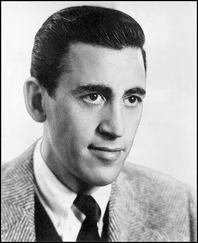J. Salinger - Nine Stories
Здесь есть возможность читать онлайн «J. Salinger - Nine Stories» весь текст электронной книги совершенно бесплатно (целиком полную версию без сокращений). В некоторых случаях можно слушать аудио, скачать через торрент в формате fb2 и присутствует краткое содержание. Жанр: Старинная литература, на английском языке. Описание произведения, (предисловие) а так же отзывы посетителей доступны на портале библиотеки ЛибКат.
- Название:Nine Stories
- Автор:
- Жанр:
- Год:неизвестен
- ISBN:нет данных
- Рейтинг книги:3 / 5. Голосов: 2
-
Избранное:Добавить в избранное
- Отзывы:
-
Ваша оценка:
- 60
- 1
- 2
- 3
- 4
- 5
Nine Stories: краткое содержание, описание и аннотация
Предлагаем к чтению аннотацию, описание, краткое содержание или предисловие (зависит от того, что написал сам автор книги «Nine Stories»). Если вы не нашли необходимую информацию о книге — напишите в комментариях, мы постараемся отыскать её.
Nine Stories — читать онлайн бесплатно полную книгу (весь текст) целиком
Ниже представлен текст книги, разбитый по страницам. Система сохранения места последней прочитанной страницы, позволяет с удобством читать онлайн бесплатно книгу «Nine Stories», без необходимости каждый раз заново искать на чём Вы остановились. Поставьте закладку, и сможете в любой момент перейти на страницу, на которой закончили чтение.
Интервал:
Закладка:
During the next couple of weeks, the picture--however forcibly or accidentally it had been planted on the Chief--was not removed from the bus. It didn't go out with the Baby Ruth wrappers and the fallen licorice whips. However, we Comanches got used to it. It gradually took on the unarresting personality of a speedometer.
But one day as we were on our way to the Park, the Chief pulled the bus over to a curb on Fifth Avenue in the Sixties, a good half mile past our baseball field. Some twenty back-seat drivers at once demanded an explanation, but the Chief gave none. Instead, he simply got into his story-telling position and swung prematurely into a fresh installment of
"The Laughing Man." He had scarcely begun, however, when someone tapped on the bus door. The Chief's reflexes were geared high that day. He literally flung himself around in his seat, yanked the operating handle of the door, and a girl in a beaver coat climbed into the bus.
Offhand, I can remember seeing just three girls in my life who struck me as having unclassifiably great beauty at first sight. One was a thin girl in a black bathing suit who was having a lot of trouble putting up an orange umbrella at Jones Beach, circa 1936. The second was a girl aboard a Caribbean cruise ship in 1939, who threw her cigarette lighter at a porpoise. And the third was the Chief's girl, Mary Hudson.
"Am I very late?" she asked the Chief, smiling at him.
She might just as well have asked if she was ugly.
"No!" the Chief said. A trifle wildly, he looked at the Comanches near his seat and signalled the row to give way. Mary Hudson sat down between me and a boy named Edgar something, whose uncle's best friend was a bootlegger. We gave her all the room in the world. Then the bus started off with a peculiar, amateur-like lurch. The Comanches, to the last man, were silent.
On the way back to our regular parking place, Mary Hudson leaned forward in her seat and gave the Chief an enthusiastic account of the trains she had missed and the train she hadn't missed; she lived in Douglaston, Long Island. The Chief was very nervous. He didn't just fail to contribute any talk of his own; he could hardly listen to hers. The gearshift knob came off in his hand, I remember.
When we got out of the bus, Mary Hudson stuck right with us. I'm sure that by the time we reached the baseball field there was on every Comanche's face a some-girls-just-don't-know-when-to-go-home look. And to really top things off, when another Comanche and I were flipping a coin to decide which team would take the field first, Mary Hudson wistfully expressed a desire to join the game. The response to this couldn't have been more clean-cut. Where before we Comanches had simply stared at her femaleness, we now glared at it. She smiled back at us. It was a shade disconcerting. Then the Chief took over, revealing what had formerly been a well-concealed flair for incompetence. He took Mary Hudson aside, just out of earshot of the Comanches, and seemed to address her solemnly, rationally. At length, Mary Hudson interrupted him, and her voice was perfectly audible to the Comanches. "But I do,"
she said. "I do, too, want to play!" The Chief nodded and tried again.
He pointed in the direction of the infield, which was soggy and pitted.
He picked up a regulation bat and demonstrated its weight. "I don't care," Mary Hudson said distinctly, "I came all the way to New York--to the dentist and everything--and I'm gonna play." The Chief nodded again but gave up. He walked cautiously over to home plate, where the Braves and the Warriors, the two Comanche teams, were waiting, and looked at me. I was captain of the Warriors. He mentioned the name of my regular center fielder, who was home sick, and suggested that Mary Hudson take his place. I said I didn't need a center fielder. The Chief asked me what the hell did I mean I didn't need a center fielder. I was shocked.
It was the first time I had heard the Chief swear. What's more, I could feel Mary Hudson smiling at me. For poise, I picked up a stone and threw it at a tree.
We took the field first. No business went out to center field the first inning. From my position on first base, I glanced behind me now and then. Each time I did, Mary Hudson waved gaily to me. She was wearing a catcher's mitt, her own adamant choice. It was a horrible sight.
Mary Hudson batted ninth on the Warriors' lineup. When I informed her of this arrangement, she made a little face and said, "Well, hurry up, then." And as a matter of fact we did seem to hurry up. She got to bat in the first inning. She took off her beaver coat--and her catcher's mitt--for the occasion and advanced to the plate in a dark-brown dress.
When I gave her a bat, she asked me why it was so heavy. The Chief left his umpire's position behind the pitcher and came forward anxiously. He told Mary Hudson to rest the end of her bat on her right shouder. "I am," she said. He told her not to choke the bat too tightly. "I'm not,"
she said. He told her to keep her eye right on the ball. "I will," she said. "Get outa the way." She swung mightily at the first ball pitched to her and hit it over the left fielder's head. It was good for an ordinary double, but Mary Hudson got to third on it--standing up.
When my astonishment had worn off, and then my awe, and then my delight, I looked over at the Chief. He didn't so much seem to be standing behind the pitcher as floating over him. He was a completely happy man. Over on third base, Mary Hudson waved to me. I waved back. I couldn't have stopped myself, even if I'd wanted to. Her stickwork aside, she happened to be a girl who knew how to wave to somebody from third base.
The rest of the game, she got on base every time she came to bat. For some reason, she seemed to hate first base; there was no holding her there. At least three times, she stole second.
Her fielding couldn't have been worse, but we were piling up too many runs to take serious notice of it. I think it would have improved if she'd gone after flies with almost anything except a catcher's mitt. She wouldn't take it off, though. She said it was cute.
The next month or so, she played baseball with the Comanches a couple of times a week (whenever she had an appointment with her dentist, apparently). Some afternoons she met the bus on time, some afternoons she was late. Sometimes she talked a blue streak in the bus, sometimes she just sat and smoked her Herbert Tareyton cigarettes (cork-tipped).
When you sat next to her in the bus, she smelled of a wonderful perfume.
One wintry day in April, after making his usual three o'clock pickup at 109th and Amsterdam, the Chief turned the loaded bus east at 110th Street and cruised routinely down Fifth Avenue. But his hair was combed wet, he had on his overcoat instead of his leather windbreaker, and I reasonably surmised that Mary Hudson was scheduled to join us. When we zipped past our usual entrance to the Park, I was sure of it. The Chief parked the bus on the comer in the Sixties appropriate to the occasion.
Then, to kill time painlessly for the Comanches, he straddled his seat backward and released a new installment of "The Laughing Man." I remember the installment to the last detail, and I must outline it briefly.
A flux of circumstances delivered the Laughing Man's best friend, his timber wolf, Black Wing, into a physical and intellectual trap set by the Dufarges. The Dufarges, aware of the Laughing Man's high sense of loyalty, offered him Black Wing's freedom in exchange for his own. In the best faith in the world, the Laughing Man agreed to these terms.
(Some of the minor mechanics of his genius were often subject to mysterious little breakdowns.) It was arranged for the Laughing Man to meet the Dufarges at midnight in a designated section of the dense forest surrounding Paris, and there, by moonlight, Black Wing would be set free. However, the Dufarges had no intention of liberating Black Wing, whom they feared and loathed. On the night of the transaction, they leashed a stand-in timber wolf for Black Wing, first dyeing its left hind foot snow white, to look like Black Wing's.
Читать дальшеИнтервал:
Закладка:
Похожие книги на «Nine Stories»
Представляем Вашему вниманию похожие книги на «Nine Stories» списком для выбора. Мы отобрали схожую по названию и смыслу литературу в надежде предоставить читателям больше вариантов отыскать новые, интересные, ещё непрочитанные произведения.
Обсуждение, отзывы о книге «Nine Stories» и просто собственные мнения читателей. Оставьте ваши комментарии, напишите, что Вы думаете о произведении, его смысле или главных героях. Укажите что конкретно понравилось, а что нет, и почему Вы так считаете.










